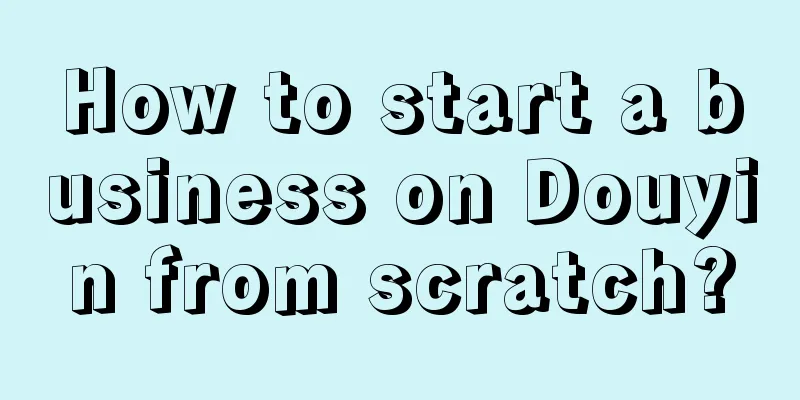Understanding the four elements of private domain transactions can greatly increase the transaction rate

There are three most basic elements when users buy things: needs/pain points, touch points, and trust. If you want to close a deal, all three elements must be present, none of them can be missing. However, when users are shopping and completing transactions, these three elements appear in three different orders. The first order is: first there is demand, then contact, and finally trust. First there is a demand, and then you look for products. At this time, you need touchpoints. Touchpoints are where users can find you, contact you, or you can contact users. Finally bought it because of trust. The second order is: first there is contact, then demand, and finally trust. Produce precise content through touchpoints to stimulate users' needs and desires, and ultimately encourage purchases based on trust. The third order is: first trust, then demand, and finally contact. Because of trust, once there is a need, we will actively find the contact point. Even if the demand is not very strong, people will choose to support and buy it because of trust. 1. ContactTo reach users is to find some points that can continuously contact users. If you want to activate users and build and strengthen trust with them faster, you need to design a reach model. The reach model is aimed at private domain users and can continuously reach out to users, such as: private messages, Moments, public account push, public account menu bar, group announcements, etc. The normal WeChat private domain user pool is a combination of official account + personal WeChat account + WeChat group. We need to find all the touch points that can reach users, connect them together, and reach users through different dimensions. As long as the frequency of contact is high enough, the user will be continuously activated by you, and the cycle of building trust with you will be shortened. For example, if a user follows your public account, and the menu bar and pushed content are directly visible or clickable by the user, this is a touchpoint. If a user posts to Moments and can see it, this is also a touchpoint. 2. DemandThe premise for users to make a deal is that they have needs and pain points, so how do you stimulate user needs and desire to buy? One of the important elements is private domain classification follow-up, which is to push different content through different users. Different users require different content influences and different follow-up strategies. Before classifying users, you must first make detailed notes for the users. Edit tags and make notes for users in the private domain. Note the user's personal introduction, user needs, pain points, concerns, interests and focuses. The user's consumption frequency, consumption price, purchased products, as well as user evaluation, feedback, suggestions, etc. also need to be noted. The more detailed the user status notes are, the better. In every chat with a user, some useful information revealed by the user should also be noted in a timely manner. Based on the user's situation, we continuously screen (delete invalid users, improve user intention), confirm needs, and set up different products to complete transactions through long-term value output, communication and interaction, as well as differences in purchasing power. Different users require different content influence and operation strategies. User classification management, label and classify different users. You need to know how to amplify users’ pain points/needs and fears/dreams through content/copywriting. 3. Trust9 principles for building trust:
The five dimensions and touchpoints for building a trust relationship are: product and service trust, relationship trust, brand trust, user resonance, and valuable content. ① Trust in products and services That is, the product or service can provide users with value and experience that exceeds expectations. ② Relationship trust It’s the relationship between you and your users. ③ Brand trust When users buy similar products, they only recognize your brand, or if you have built your own personal brand, they will only recognize you, and you are your own brand. Build brand trust. The private domain breaks the circle by relying on word-of-mouth effect. ④ User resonance Make users feel that this brand understands me very well. ⑤ Value content Content is the core capability of the private domain, and traffic, trust, and transactions all rely on content. Before publishing content, you need to first define the target audience and lock in the problem, determine what type of people your target users are, what the core problems are, and find other problems through the core problems. The more dimensions and touchpoints of trust there are, the more loyal users will be and the stronger the trust will be. 4. Transaction copywritingOnce you understand the needs, touch points, and trust, if you add a closing copy, the success rate will be greatly improved. If you want to attract users and increase the conversion rate, it is very important to write sales copy that users cannot refuse. Good copy can trigger traffic, increase conversion rate several times, and make products or brands spread quickly. So be sure to study how to write copy. The sales copy must make users curious rather than satisfy them. Transaction copy is not valuable content. Don’t just think about solving users’ problems and don’t just think about satisfying users. When you satisfy users and solve their problems, they think they understand and they are unwilling to pay. When writing sales copy, you must make sure that users are curious after reading it, but not satisfied and need to pay to be satisfied. Make users curious before collecting money, rather than satisfying them. Spend three to five hours every week studying your peers, their products, copywriting, etc., studying and analyzing your users, and collecting their problems, questions, opinions, etc. To study the desires and needs of potential users, you can go to Baidu to find related and similar questions. This is also a way to find titles. Through analysis, search, interviews, etc., we can find out the specific problems that bother users, present the problems that bother potential users the most in a form that users cannot resist, and then follow up. Spend a week making a target user problem list and demand list, including hundreds of questions and demands, preferably as specific and detailed as possible. You can also classify according to the degree of user concern. This table can be used as the title and subject of the article, the title of the sales copy, and the copy for the circle of friends. Successful copywriting does not focus on the product, but on the user. When writing copy, you should stand in the user's perspective and give users reasons to buy. We need to take advantage of the user's curiosity and plant the seed of a transaction in his heart. Sales is about constant temptation, constant arousing of users' curiosity, and finally satisfying users and closing deals with them. The copy should emphasize the benefits and experience of the product (the experience after purchase, what you can get, and what you can help users avoid). Instead of always emphasizing the functions and performance of the product. Describe the product's benefits, experience, and what you can gain and change after purchasing. Be specific and don't be too general. The copywriting with user testimonials, data, and specific details can give users more confidence. To give users confidence, we must not talk in general terms or make empty statements. Hot title elements:
Find a point that is related to the user's interests and desires, and a point that can attract his attention, so that he will feel that he should continue reading when he reads the first line of your copy. Different users require different copywriting to close deals, so you need to understand your users. Find out what your potential users are interested in and use it as a starting point to connect with them, rather than rushing to tell them about your proposition and your product. Two responses from users about the product:
Perceived value is what users get from the copy. And risk is what users need to pay in order to get these benefits. If you want to increase the conversion rate, you need to increase the user's perceived value and reduce the user's risk. At this time, you can design a sales proposal. The sales proposition is to give customers a reason to buy, a reason that they cannot refuse. The transaction proposition is to increase the user's perceived value and reduce the user's risk. Six key elements of a deal: 1) Product Benefits
2) Creating value ① Risk commitment, reducing user decision-making, ensuring zero risk or even negative risk
② Super gifts, gifts with great design value and valuable packaging of gifts The best gifts are those that are low-cost but of high value, such as virtual products such as knowledge products and services. Gifts can also be back-end products, similar to trial packages. If the gifts are used well, they will climb up your value ladder and buy products with greater value and higher prices. Super gifts must make users feel that they are getting a great deal, so the design of the gifts is very important. You must know that users may not like cheap things, but they definitely like to get a bargain. 3) Promotional offers There must be a reason for offering promotional discounts, why the discount is offered and how big the discount is. 4) User Testimonials Provide cases, user reviews and feedback, and make sure they are truthful. 5) Sense of urgency and scarcity 6) Place your order immediately The process is simple and smooth with few steps. If you want to increase your closing rate, you must know how to design your closing proposal and think about why this proposal is hard to refuse. Author: Lao Chen, public account: Lao Chen's deep thinking |
<<: Xiaohongshu's Hot Articles Routine Summary in September
>>: Xiaohongshu launches social tool
Recommend
New Year's co-branded models: the undefeated Chinese style, the people-friendly cartoon style, which one do you pick?
The Spring Festival is a traditional festival that...
There are three levels of business analysis. What does the most powerful one look like?
Business analysis has become an important part of ...
Sales in the live broadcast room surged 400 times. Has the No. 1 milk tea stock gone viral?
Xiangpiaopiao has gained huge traffic and attentio...
After Manner employees collapsed, Luckin workers couldn't sit still
After the three Manner incidents fermented, the me...
299 yuan per set, 24 hours a day, AI anchor enters the live broadcast room
Have you ever had this experience: when you open a...
Can the main account and email address of Shopee be changed? Are there any benefits to being a Shopee user?
For sellers who are opening and operating a Shopee...
The "most competitive" 618 shopping festival in history comes to an end: the melee escalates, and everyone uses their own unique tactics
During the 618 promotion, various e-commerce platf...
Is there a good prospect for cross-border e-commerce without source of goods? How to do it?
Is there a good prospect for cross-border e-commer...
What is suitable for selling on Shopee Taiwan? Where should I start when selecting products?
Shopee has many sites, but domestic sellers prefer...
With over 20 million members and an annual GMV exceeding RMB 4 billion, how does Guoquan Food manage to dominate the private catering industry?
Pre-prepared meals are common to everyone. This in...
The traffic of video accounts has suddenly increased. Some people have encountered bottlenecks, while others have started to scale up.
As an emerging e-commerce platform, Video Account ...
There are anti-counterfeiting bloggers everywhere, how do they make money?
This article deeply analyzes the phenomenon of ant...
How to spend brand money wisely
Why do many companies focus on brand issues? I bel...
How to open a new site without graduating from Shopee? What are the graduation requirements?
After a new seller successfully applies and opens ...
From data assets to journey metrics
From data accumulation to journey insights, this a...









